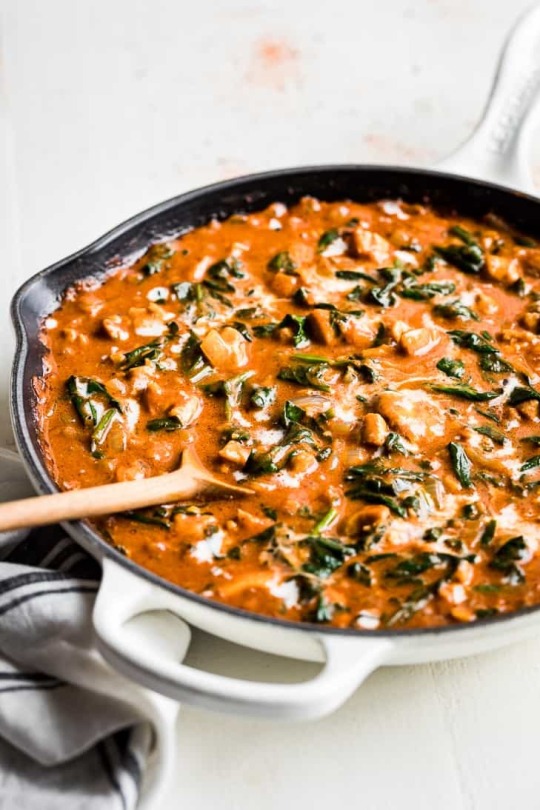#berbere
Text
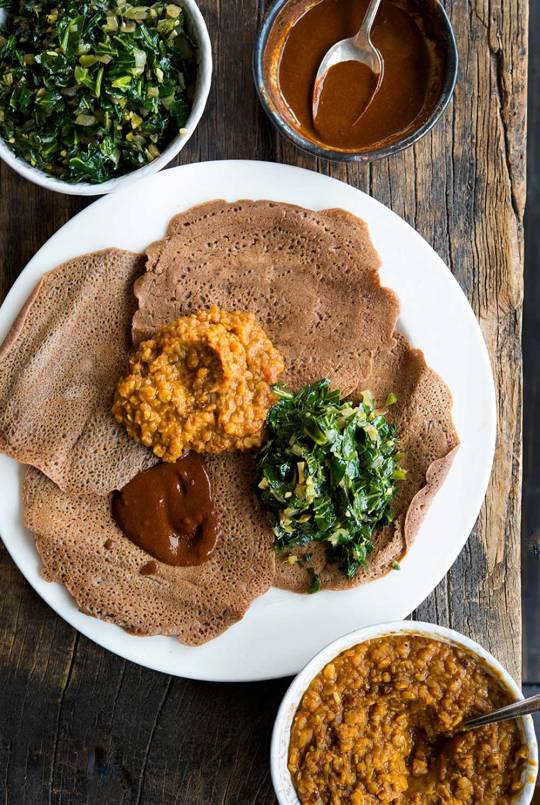
Ethiopian Red Lentil Stew and Collard Greens on Homemade Injera
#food#recipe#dinner#misir wat#gomen#collard greens#onions#tomatoes#lentils#butter#ginger#fenugreek#cardamom#cinnamon#turmeric#nigella seed#berbere#stew#garlic#bread#teff#ethiopian
84 notes
·
View notes
Text

Yetsom Beyaynetu (Vegan Ethiopian Combination Platter)
#vegan#lunch#dinner#ethiopian cuisine#east african cuisine#african cuisine#multi#stews#Yetsom Beyaynetu#injera#shiro wat#chickpeas#onion#garlic#misir wat#lentils#berbere#kik alicha#turmeric#chili#gomen#collard greens#potato#carrots#beets#lemon#olive oil#sea salt
84 notes
·
View notes
Text
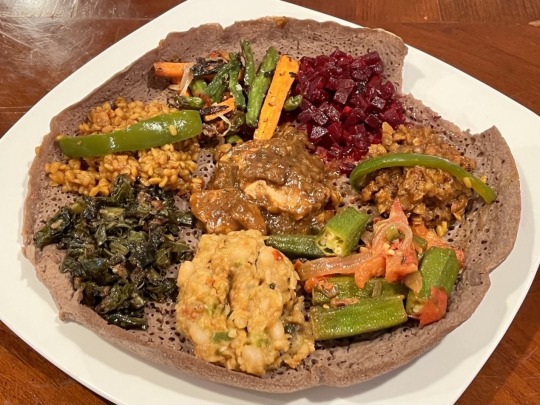
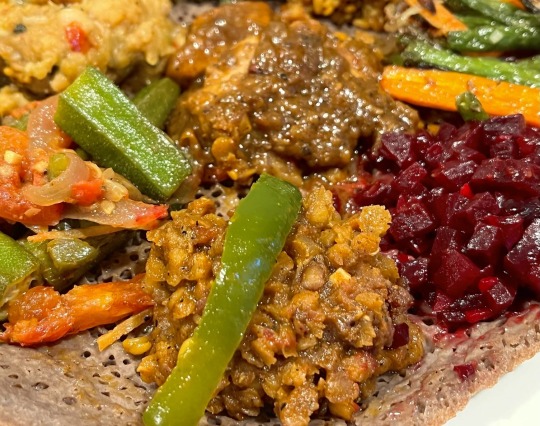
[ID: First image shows a piece of injera on a large plate covered with small servings of a variety of different vegetable dishes. Second image shows a close-up of a lentil dish garnished with sliced jalapeño. End ID.]
Misir wat (Ethiopian red lentils)
A wat (or wot) is an Ethiopian simmered stew spiced with berbere. Minimal ingredients, aromatic spice blends, and long frying and simmering times come together to produce this intensely flavorful lentil dish. The use of both a sautéing spice blend and a finishing spice blend added in closer to the end of the cooking time ensures that smooth, even heat is chased by complex floral aromatics in each bite.
Recipe under the cut!
Patreon | Tip jar
Ingredients:
2 shallots or 1 red onion, minced (1 1/2 cup)*
3 roma tomatoes, diced (1 1/2 cup)
1 tablespoon minced garlic
1/4 cup neutral oil
2 cups of warm water
1/2 tsp mekelesha (finishing spice blend)
1/4 cup berbere
1 cup (200g) split red lentils, washed
Salt to taste (3/4 - 1 tsp)
*Shallots are typically used in Ethiopia, but red onions are commonly substituted by people of Ethiopian descent in the U.S.
Instructions:
1. Cook shallots along with 1 tsp of minced garlic and a pinch of salt in a dry pan on medium high, stirring often, until they have released their water and are dry. They will become more prone to sticking and need to be stirred more often as they approach being done.
Beginning the cooking process with aromatics sans oil is traditional in Ethiopia, but if you're worried that they may stick (or don't have much time), you may add a little oil and cook the onions until they soften.
2. Add minced tomatoes and cook, stirring occasionally, until dry.
3. Reduce heat to low. Add oil and cook for 10-15 minutes, until tomatoes and shallot are very soft.
4. Add remaining 2 tsp of garlic and fry for 30 seconds until fragrant.
5. Add berbere and cook for another 30 minutes on low. If needed, add water a little at a time. Continue cooking until the shallot appears to have disappeared. Being patient during this step is important, as this is when the flavor from the berbere develops.
6. Add lentils and fry for 20-30 minutes until slightly softened, occasionally adding just enough water to prevent burning.
7. Add water to cover. Add salt and mekelesha. Cover and cook until lentils are tender.
Some recipes for misir wat call for niter kibbeh. You can add some if you like, but this is not traditional in Ethiopian lentil dishes, which are usually fully vegetarian.
#Ethiopian#recipe#cooking#vegan recipe#vegan cooking#one pot#red lentils#tomatoes#berbere#shallots#gluten free
112 notes
·
View notes
Text
30 DE AGOSTO, 26 ANIVERSARIO DEL DÍA MUNDIAL DE LA BANDERA (ukenyal) AMAZIGH.

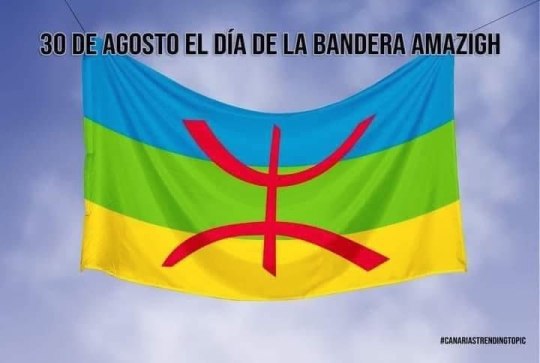
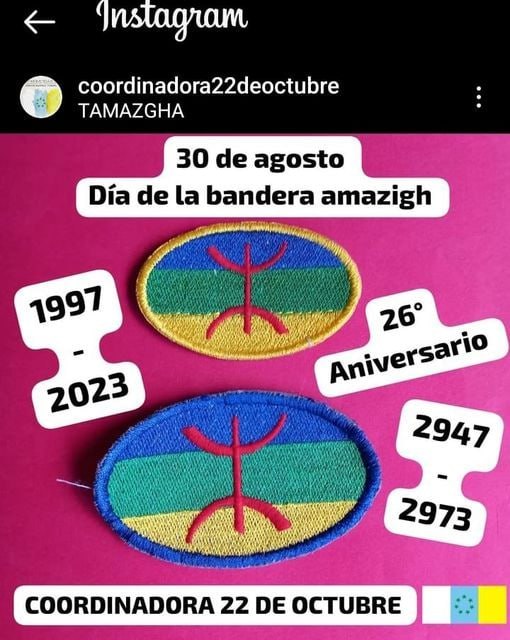

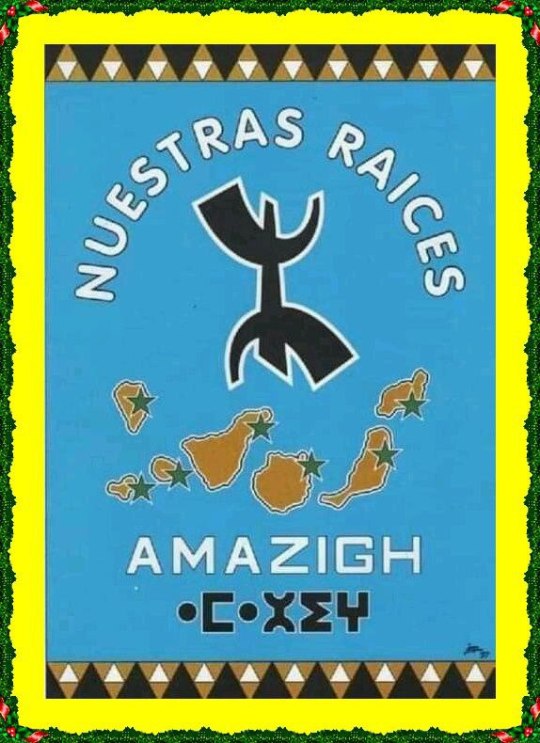
ⵣ✊🏼ⵣ ¡Feliz día
de la bandera Amazigh!
¡Viva la libertad de la Tamazgha
y de todos los pueblos imazighen!
ⵜⴻⴷⴰⵔⴰ ⵜⴰⵎⴰⵣⴳⴰ ⵜⵉⵍⴻⵍⵍⵉⵜ!
ⵀ★☆★ ☆ ★☆★
26 Aniversario del DÍA MUNDIAL
de la BANDERA (ukenyal) AMAZIGH.
ⵣⵣⵣⵣⵣⵣⵣⵣ
26º Amulli, Congrès Mondial Amazigh (CMA) - en Tamazight-.
ⵀ★☆★ ☆ ★☆★ⵀ
Cada 30 de Agosto, a raíz del Congreso Mundial Amazigh celebrado en Tafira (Las Palmas de Gran Canaria) en 1997, se celebra en todo el Mundo el nacimiento de este símbolo de unidad y libertad de los diferentes pueblos que viven en diversas regiones del norte de África (Territorio conocido como la Tamazgha) que comparten raíces culturales y lingüística comunes.
La bandera de nuestra identidad representa nuestra historia y nuestra lucha, une a todos los imazigen del mundo, y a los pueblos del norte de África: desde Siwa hasta Canarias, desde el mediterráneo hasta el río de Senegal (Tamazgha)
Los canarios, como uno de los pueblos imazighen más antiguos, lideramos, en ese Congreso histórico, la unificación de la Tamazgha y la creación de su bandera identitaria .
Los pueblos Amazigh han resistido y perdurado durante milenios, invasiones y colonizaciones incesantes (griegos, romanos , árabes... Y en la etapa moderna , europeos -franceses y españoles principalmente- y "yankees")
ⵀ★☆★ ☆ ★☆★ⵀ
La bandera Amazigh, representa la armonía de los seres humanos con su tierra.
El símbolo del hombre en rojo tiene un carácter antropomórfico, con forma humana, y ha sido conocido desde tiempos prehistóricos.
Su significado actual simboliza al pueblo Amazigh. Usado oficialmente desde que en 1966, Mohand Arav Bessaoud, fundara la Academia Amazigh .
ⵀ★☆★ ☆ ★☆★ⵀ
COLORES:
Simbolizan la costa norte de África con el Mediterráneo, el Atlántico con Canarias al Noroeste y el desierto del Sahara al sur, y su apego y su amor a su tierra.
Tienen los siguientes significados:
ⵣ☆ Banda superior azul (Amidad) : representa el mar Mediterráneo y el océano Atlantico, la costa imazighen durante milenios.
ⵣ☆ Banda central verde (Azegzaw) : significa la naturaleza y las grandes montañas (cordillera del Atlas) y tierras verdes que los imazighen han cultivado desde tiempos prehistóricos.
ⵣ☆ La banda inferior amarilla (Awragh) :
simboliza la arena del Sáhara, del desierto de la TINIRI la zona de los Tuareg, pero también la alegría y el oro o la riqueza.
ⵣ☆ El signo de la figura, a su vez, es la letra sagrada "Z" (Yas o aza) del alfabeto tifinagh (idioma Tamazigh)
En rojo, porque representa el color de la vida, pero también el color de la resistencia.
En la bandera representa el nombre dado a los Amazigh: "personas libres", que es lo que significa Amazigh (plural Imazighen).
Es el principio de vida eterna y un símbolo de la sangre de los mártires por la libertad, que defendieron y defienden su cultura y su tierra ante el colonialismo conocido (delito de lesa humanidad imprescriptible).
ⵀ★☆★ ☆ ★☆★
La bandera fue propuesta por la delegación canaria(¹), durante el Primer Congreso Mundial Amazigh, realizado los días 27, 28, 29 y 30, prolongádose hasta el 31 de Agosto de 1997 .
Al congreso acudieron representantes de los distintos pueblos del ámbito amazigh: Canarios, Rifeños, Tuaregs, Númidas, Kabilios, Chleuhs, Mozabíes Imazighen del Atlas, Soussa, Chausis, y también la diáspora amazigh estabilizada en Europa y América del Norte.
(¹) Jaime Sáenz Peñate (QPD) y Francisco Trejo Herrera , representantes de Solidaridad Canaria (S.C.) en el comité organizador, ante la ausencia de un símbolo que unificara a este pueblo milenario, con costumbres y lengua ancestrales con raíces comunes en la La Tamazgha (Norte de África) decidieron plantear en esa Primera Asamblea General, la creación de la bandera .
Se basaron en la primera propuesta oficial para que el pueblo Amazigh tuviera su propia bandera, que se hizo en el año 1971 en Roubaix (Francia) por Agraw Imazighen de la Kabilia ,como muestra cultural y de identidad.
ⵀ★☆★ ☆ ★☆★
Con mucha ilusión y éxito, fue acogida como un símbolo que , dese aquel momento, une a la comunidad Amazigh de todo el Mundo.
#bandera amazigh#amazigh#tamazgha#afrique#africa#berbere#aboriginal#aborigenous#indigenous#culture#history#genocide#native#unesco#united nations#canary islands#international criminal court#cou penal international#corte penal internacional#indígenas#aborigenes#cultura#historia#genocidio#nativos#naciones unidas#islas canarias#canarias tiene identidad cultural propia#canarias la colonia mas antigua del mundo#descolonizacion de canarias
23 notes
·
View notes
Text

Creamy Ethiopian Berbere Curry (via Get Inspired Everyday)
#gluten free#gf food#gluten free foods#meals#dessert#chicken#egg free#berbere#spinach#ethiopian food#african food#curry#getinspiredeveryday
36 notes
·
View notes
Photo

Miroir de femme à suspendre. Bois, miroir Vallée du Draa. © Musée berbère
26 notes
·
View notes
Text

Looking to SPICE up your soups and stews? Here's a great dried spice blend that you can use as a substitute to your regular seasoning mix!
#vegan#food#vegan food#foodgasm#plant based#food porn#homecook#from scratch#healthy meal#delicious recieps#healthy food#meal plan#yummy recipes#meal ideas#veganrecipes#berbere#dried spices#spice blends#vegan spices#spices#ethiopia#ethiopian cuisine#eritrean cuisine#allpurpose spices#seasoning#seasoning mix#stew#soup#dry rub#how to
32 notes
·
View notes
Text


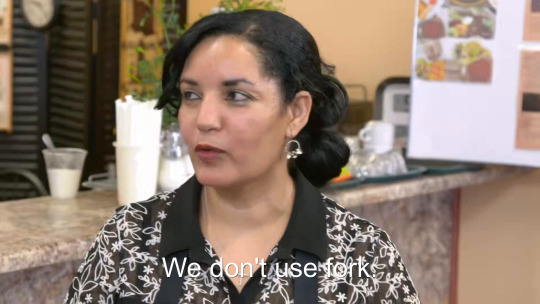
[Berbere is the main one. The main one. It's finger meal. We don't use fork.]
#s38e01 south dakota smorgasbord#guy fieri#guyfieri#diners drive-ins and dives#main one#finger meal#berbere#fork
4 notes
·
View notes
Photo
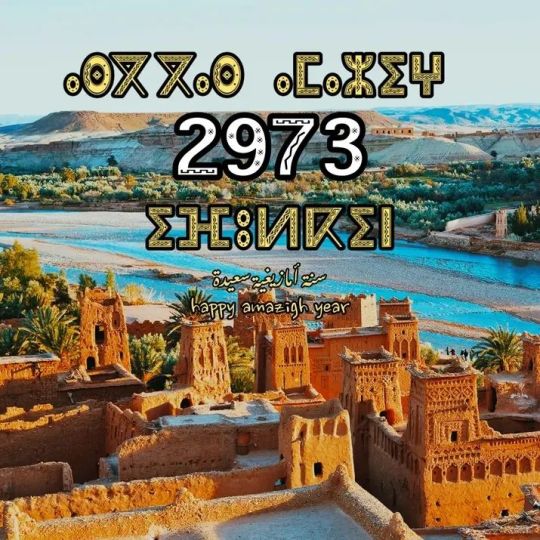
Yennayer 2973 - Amazigh New Year Party "Yennayer", a new year's celebration steeped in tradition, has been celebrated since antiquity in the Maghreb and by Maghrebis around the world. The Amazigh (Berber) New Year is one of the oldest popular festivals celebrated in North Africa. The millennial festival of "Yennayer", literally "first month" or even "door of the year", is held every year on January 12 or 13. The Amazigh calendar is an ancient agrarian solar calendar, also called "fellahi" "peasant". Yennyer is primarily a nature festival according to pagan customs, held to honor nature, drive away winter and start the new harvest year. . . . . #amazigh #imazighen #maroc #morocco #tamazight #agadir #rif #nador #chleuh #kabyle #souss #casablanca #tinghir #marrakech #maghreb #berbere #algerie #tiznit #berber #rabat #tafraout #tiziouzou #oujda #tanger #mellab #marocaine #bejaia #marruecos #photography #ahidous https://www.instagram.com/p/CnT_giKN1wc/?igshid=NGJjMDIxMWI=
#amazigh#imazighen#maroc#morocco#tamazight#agadir#rif#nador#chleuh#kabyle#souss#casablanca#tinghir#marrakech#maghreb#berbere#algerie#tiznit#berber#rabat#tafraout#tiziouzou#oujda#tanger#mellab#marocaine#bejaia#marruecos#photography#ahidous
5 notes
·
View notes
Photo

YENNAYER 2973 / 2023 à TOULOUSE Celebration de YENNAYER 2973 (Nouvel An Berbere 2023), Place du Capitole a Toulouse, Dejeuner de Yennayer (Degustation de plats traditionnels Kabyles et Berberes) et Spectacle musical, organise par l Association Kabyle Berbere Toulouse AFRIKA31 pour promotion de la culture kabyle, berbere et amazigh a toulouse. France, Toulouse le 15 Janvier 2023. ➡️ #AbacaPress #Abaca #Saif #Photographie #presse ➡️ #toulouse #Culture #Berbere #Yennayer #2973 #2023 #Kabyles #musique #danse #famille #photography #femmephotographe #photodocumentaire #press #photographie #leicawomenfotoproject #leicawomen #myleicaphoto #femmes #photojournalisme @leicawomen #womenstreetphotographers #womenphotographer #photodocumentary 📸 photo @patricia.huchot_boissier / @_abaca_ / #LaSaifImages Série disponible sur #PixPalace et #Reuters https://linktr.ee/p.huchotboissier (à Toulouse) https://www.instagram.com/p/CndAwK7DcX9/?igshid=NGJjMDIxMWI=
#abacapress#abaca#saif#photographie#presse#toulouse#culture#berbere#yennayer#2973#2023#kabyles#musique#danse#famille#photography#femmephotographe#photodocumentaire#press#leicawomenfotoproject#leicawomen#myleicaphoto#femmes#photojournalisme#womenstreetphotographers#womenphotographer#photodocumentary#lasaifimages#pixpalace
2 notes
·
View notes
Text

« La vie est un métier dont les fils sont les jours.
Dieu décide quand couper les fils, même si [le travail] est inachevé.
Proverbe berbère ancien
6 notes
·
View notes
Text
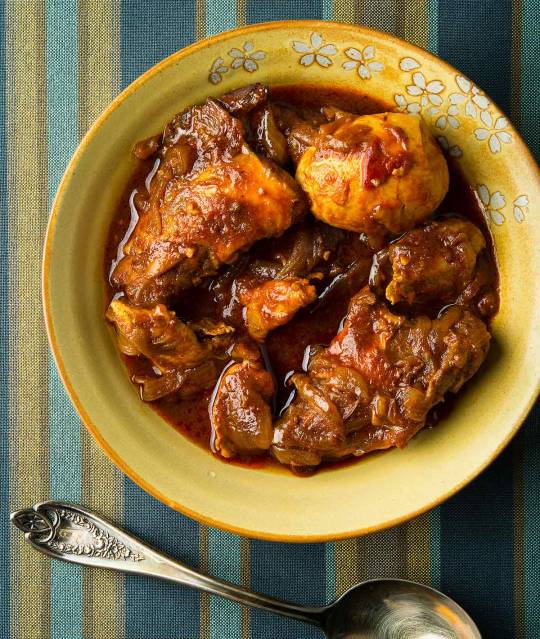
Doro Wat
#food#recipe#dinner#doro wat#stew#berbere#chicken#onions#tomatoes#ginger#garlic#lemon#fenugreek#eggs#ethiopian#gluten free
111 notes
·
View notes
Text

[ID: A close-up on the bottom right of a bowl filled with a red, brown, and yellow spice blend. The rest of the frame is taken up by scattered brown chili flakes, ajwain, and fenugreek seeds. End ID.]
Berbere / በርበረ (Ethiopian spice blend)
Berbere is a spice blend commonly used to flavor meat and vegetable dishes in the horn of Africa; mostly made up of Ethiopian brown chili peppers, it also commonly includes garlic and shallot, false cardamom, carom and nigella seeds, high-roasted fenugreek, cinnamon, and other spices and herbs. This recipe for an Ethiopian-style berbere produces a blend that imparts a smooth, even heat and a slight camphorous aroma to your final dish.
Premade berbere blends, even those from speciality spice stores, cut corners and cut costs—even if the spices are fresh and have always been stored sealed, the blend is unlikely to contain Ethiopian brown chilis, korerima, or besobela. This recipe provides a good baseline for a typical Ethiopian berbere if you're able to get your hands on these spices, rather than relying on undisclosed substitutions—but it does provide substitutions for anything you're unlikely to find in a local halaal grocery store in the U.S. or Europe. To avoid confusion with overlapping English translations (and because many recipes contain errors caused by them), Amharic terms, botanical (Latin) names, and false cognates to beware of are provided whenever necessary.
Recipe under the cut!
Patreon | Tip jar
Ingredients:
1/4 cup dried ground Ethiopian brown chili (berbere), or substitute New Mexico chilis
1 Tbsp sweet paprika (optional)
2 tsp garlic powder (nech shinkurt / ነጭ ሽንኩርት)
2 tsp dehydrated shallot or red onion (key shinkurt / ቀይ ሽንኩርት)
2 tsp false cardamom (korerima / ኮረሪማ; Aframomum melegueta)
1 tsp coriander seeds (dimbilal / ድንብላል)
1 tsp black mustard seeds (senafitch / ሰናፍጭ; Brassica nigra) (optional)
1/2 tsp fenugreek (abish or hulbet / አብሽ; Trigonella foenum-graecum), dark-roasted
1/2 tsp nutmeg (gewz; Myristica fragrans)
1/4 tsp ground ginger (zinjibel / ዝንጅብል; Zingiber officinale)
1/4 tsp carom seeds (nech azmud / ነጭ አዝሙድ; Trachyspermum ammi)
1/4 tsp nigella seeds (tikur azmud / ጥቁር አዝሙድ; Nigella sativa)
1/8 tsp true (Ceylon) cinnamon (k'elefa / ቀረፋ; Cinnamomum verum), or substitute cassia cinnamon
4 pieces Ethiopian long pepper (timiz; Piper capense); or Indian long pepper (Piper longum), also sometimes used under the name "timiz"
5 whole cloves (krenfud / ቅርንፉድ)
1 tsp Ethiopian holy basil (besobela / በሶቢላ)
1 tsp rue seeds (tena Adam / ጤናዳም; Ruta chalepenesis)
1 tsp Ethiopian rape seeds / Ethiopian mustard seeds (Brassica carinata), or substitute niger seeds (Guizotia abyssinica)
1 tsp koseret (ኮሰረት; Lippia abyssinica) (optional)
2 tsp salt
Berbere preparations vary from household to household, and spices may be added, removed, or rebalanced according to your preference. Less common inclusions are marked as optional; the spices and herbs that are the most vital are bolded.
See end notes for information on spices and substitions.
Instructions:
1. Heat a dry skillet over medium. Roast fenugreek, agitating occasionally, until it has considerably darkened to a medium brown. Set aside. Toast cinnamon, cloves, and korerima for a few minutes until fragrant and set aside.
2. Toast smaller whole spices (carom and nigella seeds) for a few minutes until fragrant and set aside.
3. Remove the pan from heat. Toast ground spices (ginger, paprika) for 30 seconds, stirring constantly, until fragrant.
4. Use a mortar and pestle or a spice grinder to grind all ingredients to a fine consistency. Pass through a fine mesh strainer and store in an airtight container in a cool, dark place.
Notes on spices and herbs
Ethiopian brown chili pepper / berbere

Known as "berbere" in Ethiopia, Ethiopian brown chilis have a rich, smoky, and tangy heat. Dried Ethiopian brown chilis or chili flakes may be purchased online, or you may substitute another type of chili (my choice would be New Mexico).
Paprika
Different varieties of paprika are all made of dried, toasted, and ground red bell peppers, but they vary in heat and in smokiness. For berbere you will need sweet paprika (not smoked paprika, hot paprika, or smoked hot paprika). The proportion of berbere to paprika can be varied a bit according to your preference to produce a milder or hotter blend, but beware of recipes calling for large amounts of paprika—berbere should be mostly chilis!
Dehydrated shallot
Shallots have a flavor similar to those of garlic and onion, but subtler and milder. Dehydrated shallot may be purchased at speciality spice stores, or online—or you can dehydrate thinly sliced shallots in a dehydrator or in an oven on low. Red onion powder is a possible substitute, as red onions are commonly used in place of shallots by people of Ethiopian descent in the United States.
Korerima / false cardamom

Korerima is also known as "grains of paradise," "black cardamom," or "false cardamom." Some recipes mistakenly call for Nepal cardamom in place of korerima, because Nepal cardamom is also known as "black cardamom" in English. The aroma of korerima once ground, though, is much more akin to that of green cardamom than to the smoky, camphorous aroma of Nepal cardamom.
Fenugreek / abish

Fenugreek seeds may be found in any halaal grocery store, where they may be called fenugreek or methi.
Carom seeds / nech azmud

Carom seeds may be found in any halaal grocery store, where they will be known as ajwain. You may also see these referred to as "white cumin" or "caraway seeds" in English, but don't confuse them with true caraway seeds (Carum carvi), which are larger.
Nigella seeds / tikur azmud

Because "tikur azmud" literally translates to "black cumin" in English, some recipes make the mistake of calling for kala jeera (Indian black cumin)—however, the seeds are from different plants entirely. "Tikur azmud" refers to the seeds of the Nigella sativa plant, which are known as nigella seeds in English cooking and kalonji in Indian cooking.
Ceylon cinnamon

Ceylon or true cinnamon is a variety of cinnamon commonly grown in Ceylon, Sri Lanka; it has a subtler, more nuanced and less bitter flavor than cassia cinnamon. Because it must be rolled by hand (unlike cassia cinnamon, which curls naturally), it tends to be more expensive than cassia. If you can't locate any Ceylon cinnamon, though, cassia is a good substitution.
Holy basil / besobela

Ethiopian holy basil is a subspecies of basil whose flowers have a distinctive fruity or tea-like aroma. Some recipes call for basil in place of besobela, but to my nose the aromas are nothing alike; I would favor camomile as a substitution, or omit the herb altogether.
Rue seeds / tena adam

"Tena Adam" (lit., "health of Adam) or "rue" is an aromatic plant the dried fruits of which are used in spice blends including berbere (the leaves are often used to flavor coffee). Ethiopian rue may be purchased online, or you may substitute for it a pinch of lemon or orange zest.
Long pepper / timiz
The berries of Piper capense, also known as African long pepper or Ethiopian long pepper. Piper capense grows across west Africa, south Africa, and the horn of Africa. Timiz is smoky, camphorous, and resinous, not as spicy or sharp as black or white pepper. Piper longum (Indian long pepper) berries, which are sharper in taste, are best known for their cultivation in Southeast Asia, but they are also grown and eaten in East Africa and may also be referred to as "timiz." In the U.S. and Europe, Ethiopian long pepper may be found online, or at a speciality African foods store, where it will be labelled "timiz"; Indian long pepper may be found at an Indian or halaal grocery store, where it will be labelled "pippali."
Salt
Traditional berbere blends typically contain salt. I tend to omit it, as it allows for more control over the salt content of a dish later on.
88 notes
·
View notes
Text
portraits de Ait Chribou par Jarle Hvidsten
Nouvel article publié sur https://www.2tout2rien.fr/portraits-de-ait-chribou-par-jarle-hagen/
portraits de Ait Chribou par Jarle Hvidsten

#Ait Chribou#Aït Khadji#atlas#berbere#GglNoInd#Jarle Hagen#Jarle Hvidsten#maroc#photographe#portrait#Tighourdine#imxok#people#voyage
0 notes
Text
Ethiopian Berbere chicken wings

0 notes
